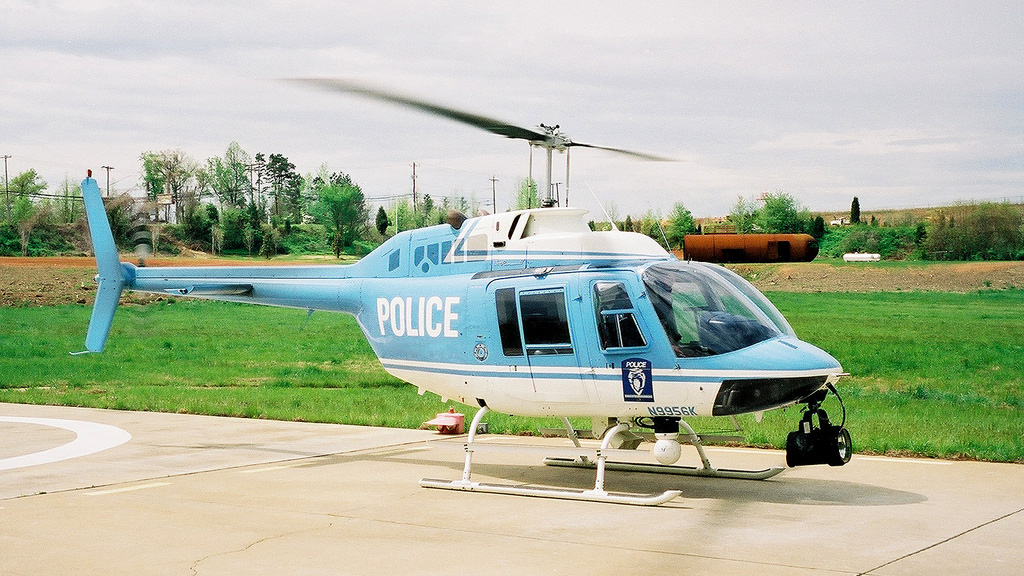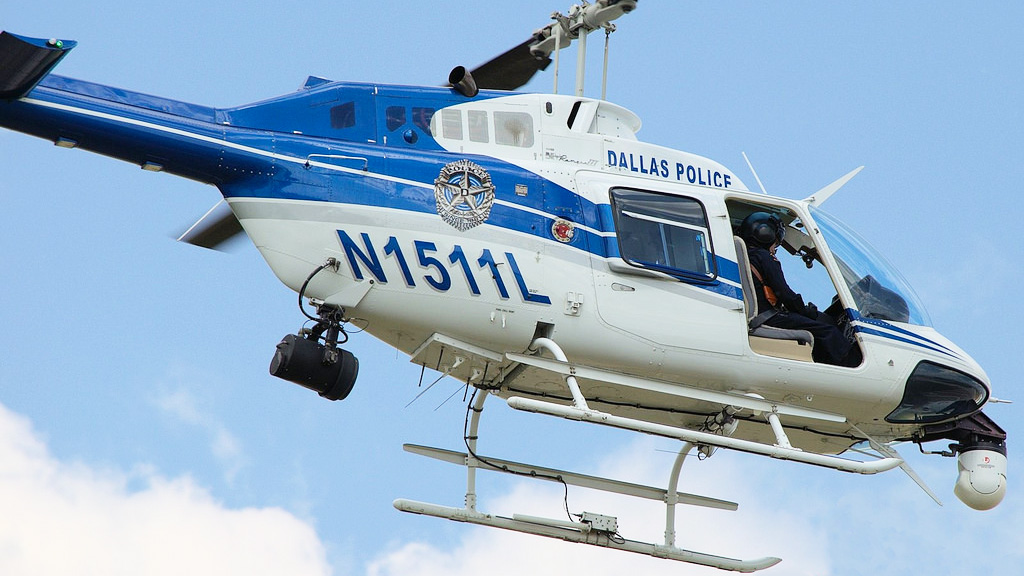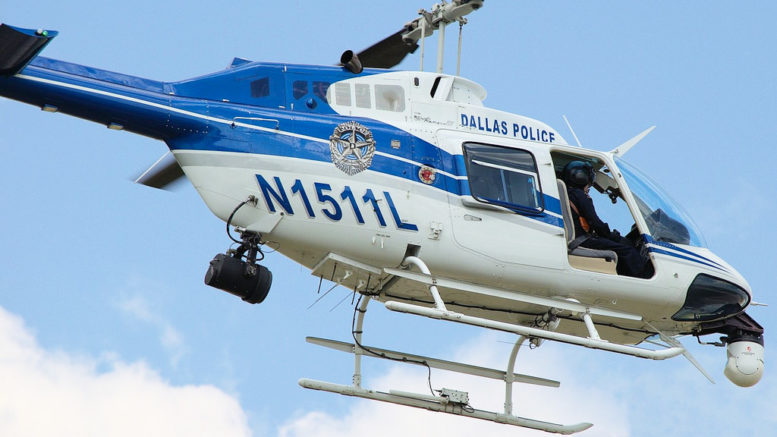Dallas Law Enforcement From The Sky
ARTICLE DATE: March 1990
THEIR OFFICIAL NAME IS THE DALLAS Police Helicopter Section, but a better name for these policemen who hover over a sleeping city at night would be “Angel Patrol.”
“We support the officer on the ground,” is their own description of what they do. They always use the word “officer.” Not once, all night long beneath that huge harvest moon, did I ever hear anyone say “cop.”
The back seat of a Bell JetRanger III is no place to be with a weak stomach. While the rotary wing seems immune to ordinary turbulence and chop, the only things that will turn as fast and tight as a helicopter are some carnival rides I never took.
The problem is where to look. In low pursuit of a bad guy in the bushes behind a warehouse, the horizon is laid over on its side and flashing by in blurred streaks of colored lights.
You can try to look straight down out the side window at the brilliant white spot of the 32-million-candlepower “night sun” light and watch the scene below revolve on its brilliant turntable, but either way you can bet your life you’ll be filled with regret about the hamburger and onions you ate for supper.
That “night sun” light is in constant use during a search or a chase. It can be focused to a piercing spot or spread out to a broad flood. Gimbal-mounted on the chin of the JetRanger Police Helicopter, it is deftly controlled by the observer pilot.
Big as a bucket, it will set dry grass afire if turned on while the helicopter is on the ground. I saw the city of Dallas, its skyline, suburbs, warehouse districts—all of it—as I had never seen Dallas before. Normal Police Helicopter patrol altitudes are 400 feet in the daytime, 600 feet at night.
But like a hunting hawk in pursuit of a rodent, the helicopter will drop down and pursue its quarry at pants-pocket level if there is room for the rotor. Both Police Helicopter officers aboard are qualified pilots and take turns flying pilot-in-command or observer.
And although the JetRanger III has an endurance of four hours, “We average an hour-and-a-half patrol, then back to base and wait for the phone,” said one pilot, citing the intense concentration it takes to weave a helicopter between tall buildings and TV towers.
I agree. I sat in back and saw the clear Texas sunset from the altitude of powerline grids, gleaming gold. It is standard procedure for one pilot to say “powerlines,” echoed quietly by the other whenever we hovered near those deadly webs.
Many hours later I saw the sun rise again as we orbited Dallas and Dallas orbited the sun. There is a shift change at 11 p.m., but I didn’t make it through those predawn graveyard hours when even drunks and burglars have gone home to their mothers.
In the ready room they saw me fading and said, “Bax, roll over on that couch and take a nap.” I needed that. There wasn’t a call until about daybreak; by then I was ready to jump and run for the bird behind the crew.
But while it was broad daylight and I was riding with officers A1 Castleman and Steve Jones, we saw a dope deal under way in the narrow courtyard of a housing project. Being in a helicopter, notebook in hand, I failed to identify whose voice I was hearing.
But this is the way it went: “See the guy in the white shirt, he’s selling dope,” said one pilot. There were several men leaning over the hood of a car. We circled twice hoping that the oppressive beat-beat-beat of the blades would at least jangle their nerves.
But they didn’t even look up. They knew we couldn’t get in, and their lookouts would have spotted a squad car in plenty of time for them to scatter. A quiet voice over the intercom explained, “When a helicopter circles low over innocent people, they always look up. The bad guys never do.”
Seems like we could have at least carried a load of hot tar and feathers, which is a traditional Old South manner of dealing with social problems. Our radio call was in sequence with the numbering system of Dallas squad cars, but the dispatcher seldom said any more than, “Helicopter, burglary in progress, a warehouse at…” and then the street address.
Crossing Dallas in a beeline at about 90 mph we were there in minutes. Officers on the ground always acknowledged us and identified themselves with a few upward winks of their flashlights even though we were close enough to plainly see a uniformed officer.
And what we could see was surprising. As an officer was climbing the chain-link fence surrounding the warehouse yard. The helicopter radioed the squad car, “Tell him there is a big red dog waiting in the shadows by the doorway, and we don’t see a chain on him.” The officer backed down off the fence, his pants saved.
Dispatch called us to a high-speed chase on the other side of town. It was a red Camaro. “Can he outrun us?” I asked. “Not often. He has to turn square corners—we don’t.” The helicopter plays a little known but vital safety role in the run of any emergency vehicle. With a view of several intersections ahead, it can warn an ambulance of conflicting cross traffic.
Tonight the squad car got close enough to the red Camaro to get his license number, then lost the subject in city traffic. Our Police Helicopter crew said, “Bet he’s going home,” and got the home address of the fleeing car. The streets of Dallas seemed to be crawling with red Camaros that night.
By the time we had circled each one and checked it out, the fugitive had made it home. Dispatch told us there were four or five warrants out on the owner. We arrived at the good ole boy’s house and lit it up like a birthday cake.
There were several vehicles in the driveway and in front of the house, including one under a blue-cloth car cover. A squad car pulled up, officers lifted the blue cloth, and there was our red Camaro. Gotcha!
All night long I was amazed to see the Police Helicopter crew pinpoint street addresses and arrive over them without ever making a false turn. These officers can run right up to your house and knock on your door more surely than a pizza delivery and three times as fast.
There is a bullhorn on the belly of the helicopter, but we never used it. Each time we were called we were working in tight coordination with nearby squad cars. “We are police officers first,” said one of the second shift of pilots.
“We always wear our side arms and badges, and there are times when the officer on the ground is being over-whelmed and we either distract the [suspect] with a close hover, or the observer pilot will jump out and join the fight.” I was surprised to learn that nearly all of the pilots are veteran police officers with 10 or 15 years on the force.
The city of Dallas does not spring for the cost of helicopter ratings for these officers, who must fork over more than $5,000 from their own paychecks to earn the opportunity to fly. Two Bell JetRanger IIIs and a McDonnell Douglas MD 500 are on regular call around the clock, with their own maintenance crew in a spotless shop located at Dallas’ Redbird Airport.
When not in flight the pilots have a couple of lounge chairs in the ready room, a Coca-Cola machine and a TV to relax to. The telephone sits between them. When a call comes in, reaction time is quick. While one pilot is already talking to the dispatcher, the other is pulling his boots on.
The Police Helicopter is parked on the ramp beside its own ground-power unit and refueling pit. The pilots sprint to the aircraft and the command pilot hops in the cockpit while the observer pilot tends the GPU. They take off in a backward rush.
“It’s a double check to be sure the GPU cable is disconnected. At the worst it would just pull on the nose. A connected takeoff over the cable could tumble the machine. It’s happened, but not to us,” said one pilot.
One of the most valuable and sophisticated crime stoppers that the Dallas helicopter section uses is called the Forward Looking Infrared, a.k.a. “FLIR.” This device, about the size of the “night sun” light and mounted on the helicopter’s belly, paints a clear, sharp picture of objects on a cockpit display screen by sensing differences in temperature.
A hot, sweaty fugitive hiding in the brush where the light can’t find him stands out like neon on a black-and-white FLIR screen. The Police Helicopter pilots demonstrated the FLIR for me out over a lake. It was dark, and there was a car parked.
“He just got there, see how his engine heat paints a lighter pattern around the edges of his hood. He needs brake work, too—look how light and hot all of his wheels are. There they go, one is wearing a jacket; it holds in his body heat. They’re carrying an ice cooler between them—the cold dark square—and the hot spot is their lantern. Picnickers.”
They told me how they caught some car strippers in the woods, the FLIR letting them look right through the trees. “One of them hid from us in the lake, but his swimming stirred the cool water up off the bottom, making a pattern in the warmer surface water. He was in a perfect infrared bull’s-eye.” Gotcha!
Unfortunately, only one of the JetRangers has the FLIR. The unit costs $100,000, but its value was not understood in the Dallas city council room. It was, however, fully understood by David Cook, a private citizen who operates a Blockbuster Video store and who has had his share of break-ins. Cook went out and bought one and donated it to the Dallas police department.
I saw the city of Dallas, its skyline, suburbs, warehouses, as I had never seen Dallas before. From the JetRanger Police Helicopter the city flashed by in blurred streaks of colored light.
The night wore on, shifts came and went. R.B. White, Mike Warren, Russell Brookshire, Terry Creighton—they shared it all with me. Most of what happened is what didn’t happen.
The whop-whop of the two rotor blades and the glaring light that announced our sudden arrival always altered the plan within the most larcenous mind. Crime changed to escape, immediately. Back at the hangar the crews began to tell roof stories.
Entering from and hiding on the roof used to be a favorite high ground for hijackers, but not anymore. One story was about the time a fugitive surrendered, but not before mooning the pilots. Another was about a guy they herded along by tilting the rotor and blasting him with blown roof gravel.
Or there were the two fugitives who were well hidden, standing up in a big rooftop ventilator. They were invisible, except for their shoes—a neat, conspicuous row of shoes. The storytelling was interrupted by a call to a carnival in the Trinity River bottom. A three-year-old boy, lost.
The Bell JetRanger Police Helicopter zipped low into the scene, nose down as if it were sniffing the powder and smoke from the magnificent public fireworks display. Those bursting rockets and carnations of color bloomed alongside us. An unforgettable way to see a fireworks display.
With a description of what the little boy was wearing, we hurried to the dark, steep banks of the old Trinity. With both the “night sun” and the FLIR operating, we made a low, slow scan of the river banks. Not there. Then we began a search of the crowd. I noticed that no one looked up at us.
“It’s that rock band they’ve got on the stage over there. They can’t hear us,” one pilot said. Good grief. Dispatch called us later that night and told us they had found the boy after the crowd thinned out.
They called because they knew we were still worried about him. Dallas was having a fairly quiet night, taking into consideration that full moon and all. There was another surge of activity around two a.m., when the beer joints closed.
Then we were called to assist in the search for a burglar in a neighborhood of expensive homes and backyard swimming pools. Squad cars were already there. Our observer said, “Look at the trails they leave in the dew on the lawns. You don’t notice that from ground level.”
From the circling Police Helicopter every officer on foot was leaving a visible pathway through the dew. Again, the most important thing that happened here was what didn’t happen. Our reaction time to phone calls at the Redbird base was always a matter of minutes.
I was starting to feel at home in the back seat of the JetRanger, and knew to follow procedure after touchdown and always walk forward toward the nose, never toward the tail and its invisible deadly rotor. There was one more call in the early Sunday morning daylight, a burglar chase.
Sgt. Don Crum flew this one, my host on this assignment. He was a fine-looking officer, the kind TV shows model after. When he met me at the airport Saturday I asked him where was Lt. Will Ricketts, who had made the original invitation. Crum looked away, trying to find some non-bitter way of telling me.
With only a few months to go for a 20-year retirement, Ricketts had resigned over a policy dispute and gone into industry flying. Since that night with the Dallas police helicopter section I have asked around and found that their problems with city hall are not unique.
Often in cities advanced enough to operate a Police Helicopter section, their governments see only the expense of operating a service they don’t understand. A brief night ride over their own concrete jungles might open the bureaucrats’ minds.
If you want to gladden the heart of every criminal in your city, cut back or take down those nosy, speedy helicopters and the dedicated officers who fly them. Bring back the good old days when a car thief or burglar had an even chance.




I have the latest night vision device in my hands in Houston and would love to bring it by to show it off to your chopper pilots any night of your choosing. It’s called the L-3Harris model 31a and is the best available, used today by Marines and SEAL units. It makes the darkest night like daylight in black and white. Please let me know if you’re interested in looking at the unit for your night time pilots. Alan 281-743-2262.